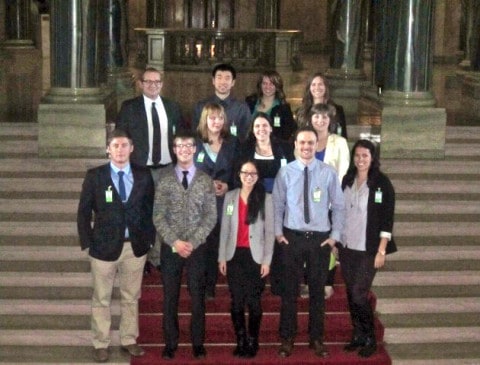
Medical students in Saskatchewan have demonstrated their concern for and commitment to being included in drafting recommendations for a human resource plan for physicians.
First-year medical student Jessica Harris attended the provincial Lobby Day and said that the Students’ Medical Society of Saskatchewan received positive feedback.
“We had a commitment from their MLAs to keep the government accountable to this end. Meetings with the government were equally promising. The minister of health agreed to further discussions on the matter and we have had positive follow-up with him since,” Harris said.
Twelve members of the SMSS met with the nine NDP Members of the Legislative Assembly, the legislative human services committee as well as Dustin Duncan and Randy Weeks, ministers of health and remote and rural health respectively. The students also attended question period.
Health Intelligence Inc. has been contracted by the provincial government to gather information in order to predict the number and kinds of physicians Saskatchewan will need in the coming three, five and 10 years.
The report will assemble information on regional and provincial scales pertaining to population trends, demographics and health factors such as incidence of disease, birth rates and surgical volumes. These statistics will then be combined with the amount of physicians in Saskatchewan, care models and service delivery to create recommendations for each community in the province.
Brad Havervold, executive director of Workforce Planning for the Government of Saskatchewan, said that Health Intelligence Inc. has been in contact with the SMSS and will continue that relationship as long as the society is interested.
Once the report is published in the fall of 2014, Havervold said the province will talk with many of the stakeholders in the province, including the University of Saskatchewan’s College of Medicine, the health regions and the SMSS, to create recommendations to act upon the report.
Havervold said the Saskatchewan government undertook this project when it became clear that physicians in the province were in need of a human resources plan. Annual resource plans are published for the other health providers such as nurses and physical therapists.
“We’ve not had for a number of years — I believe 15 or more in my experience — a solid physician resource plan that is based on the evidence of what the population actually is like and what they need going forward,” Havervold said. “That’s why we felt it was important for us to actually do some of this now.”
Harris said that having students on the steering committee would be beneficial for them as future physicians and for patients.
“What we advocate for as medical students . . . what everyone in the health-care system is advocating for is the benefit of the patient. We want the best health care available for the patients of Saskatchewan,” Harris said.
First-year medical student Cheyanne Vetter echoed Harris in saying that the report will above all benefit the people of Saskatchewan.
“It really is about getting the right people in the right places so that everybody in Saskatchewan can have access to health care,” Vetter said.
As the Saskatchewan government has already invested in creating the report, Harris said the amount of money spent on a steering committee to oversee the recommendations would be small compared to the amount that seeps through an inefficient health-care system.
“We need to be able to understand where the problem lies and then how to address that” issue, Harris said.
The SMSS has compared a similar report Health Intelligence Inc. issued for Nova Scotia in 2012 and found many parallels with Saskatchewan, including the number of physicians and dealing with rural health care. However, in Nova Scotia there is representation from each of the health districts but physicians and medical students are not represented, which is something Harris said should change in Saskatchewan.
“To us it looks very governmental and procedural rather than getting the pulse of what’s really going on in the health-care field,” she said. “We want one of our student representatives to sit on that council and to help influence the policy changes that would come from those results.”
—
Photo: Supplied